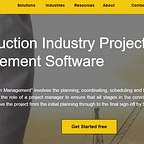Risk Reduction on Infrastructure Projects
Risk reduction on infrastructure projects can present many different logistical challenges. Getting it wrong right at the start will bring years of headaches. But, by taking a proactive approach, stakeholders can reduce uncertainty during the planning stage. This gives project managers insight into mitigating risks on future infrastructure projects using lessons learned to save on future project costs.
Risks on infrastructure projects are predictable. These can include the insecurity of funds, cost of project overruns, failing to source materials and workers, and delays. These are the common challenges stakeholders face during large infrastructure projects.
It takes hands on project management to juggle all moving parts of a long-term infrastructure to keep it on track.
Risk performance influenced by uncertainty
According to the Institute of Risk Management research, Managing cost, risk & Uncertainty in infrastructure projects, project managers face many challenges. This most important phase of a long-term, infrastructure project is during in the early, planning stages. A lack of transparent risk assessment during this phase can mean high risk and uncertainty throughout the project. This can cause:
- completing a risk analysis with different possible outcomes
- poor decision-making
- stakeholder optimism — delusion or deception
- loss of focus and sub-optimal risk mitigation.
Risk analysis challenges
A risk analysis is subjective, especially on infrastructure projects. Why? There is no clear way of progressing hypothetical risk analysis to project specific cost analysis within a commercial structure. There is also a tendency to exaggerate how well mitigation strategies work. So, project managers identify unnecessary risks or overestimate the effects of mitigating project risks. This leads to overestimating costs.
Challenges of poor decision-making
An Institute for Government (IfG) report, What’s wrong with infrastructure decision making? found the following key flaws in stakeholder decision-making for infrastructure projects:
- No strategies for investing in infrastructure. Stakeholders often do not have clear strategies for investing in infrastructure projects. Without infrastructure investment strategies, it is difficult to make good decisions. Also, there is nothing to measure project outcomes against.
- Little attention paid to assessing options at the start. Stakeholders spend too little time during project development looking at all the options. This can result in missing better project options causing project cost blow outs.
- Misunderstanding project risks. Decision-makers can misunderstand project risks. This can mean there is little forward planning for when things go wrong.
- Winners and losers. Infrastructure projects can divide communities and create winners and losers. These groups can have a lot of influence on decision-makers and cause project delays.
- Lack of project measurement. Stakeholders fail to measure infrastructure project outcomes against the costs when completed. Having key performance measures is an invaluable tool for future use. This helps stakeholders to learn from past mistakes when commissioning new infrastructure projects.
Challenges of stakeholder optimism — delusion or deception
Reducing risk on large infrastructure projects depend on whether:
- the assumptions stakeholders adopt are strategic misrepresentation or genuine optimism
- financial managers ignore/misunderstand real risk levels while pressuring for cost reductions to meet short-term financial goals
- there has been an overestimation of the risks by project managers to secure a larger contingency fund and, thus, cover all bases
- pricing from contractors is low to remain competitive but they may use other means to maintain a profit
- there is resistance from project managers to processes and procedures that reduce contingencies and risks.
Complex projects increase these risks. Taking control and ensuring transparency from the start helps reduce infrastructure project risks. You can mitigate risks during the contract phase.
Reduce risks during the contract phase
It can take years to fully complete infrastructure projects, so they have long-term project plans and phases. During this time legislation and regulations can change. This needs careful consideration during the contract phase, especially if dealing with European contractors. Consider the following:
- Are there higher costs related to dealing with a European contractor? Look at the different legislation between the two countries.
- If there are changes to immigration legislation that impacts the contractor’s access to workers, who is responsible for this?
- Who is responsible for paying the taxes between the UK and the EU?
You should also consider the risks associated with currency variations, as well as the continuity and cost of a skilled workforce. If sourcing skilled workers from overseas, can you maintain the workforce for the duration of the project?
It is important to mitigate these types of risks at the contract stage. Having these set out in contracts before starting the work can reduce costly potential conflicts during long-running infrastructure projects.
Overcome challenges on infrastructure projects using transparency. Good construction risk management software or Infrastructure project management software can give all stakeholders the transparency required. Planning a realistic acquisition program allows all stakeholders to fully investigate all the options. Once these are clear, you can take a logical approach that accounts for emerging technology and changing economic times.
Tags:
infrastructure project management
